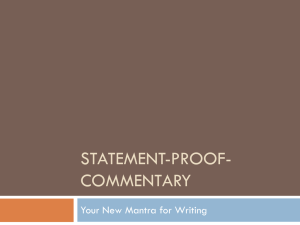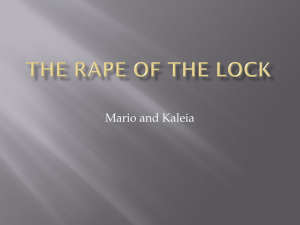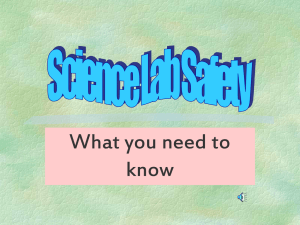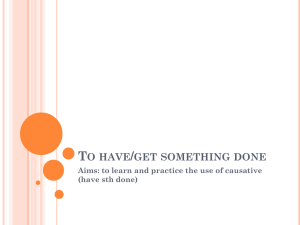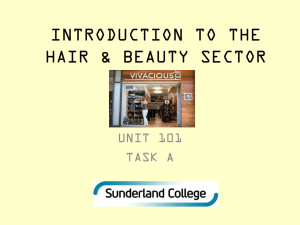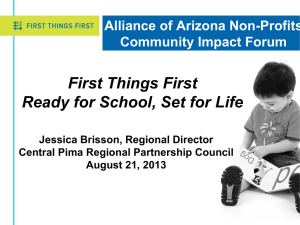Pollution Prevention Through Community Participation - CLU-IN
advertisement
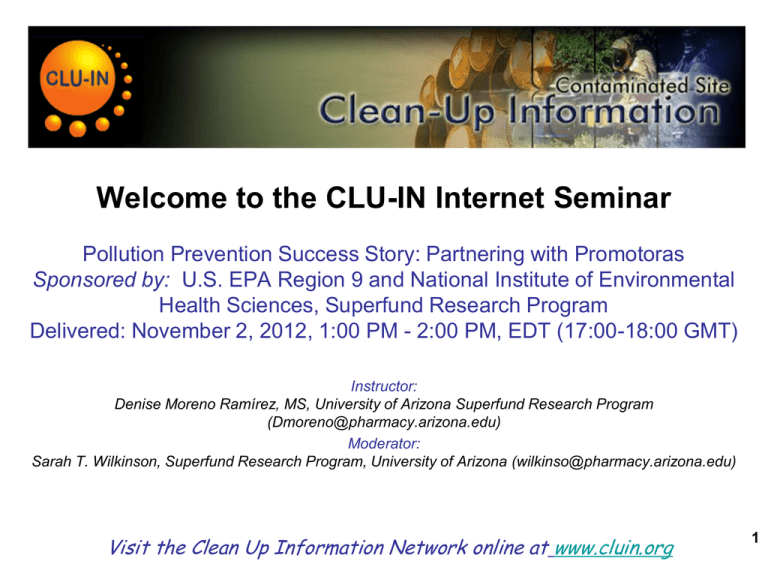
Welcome to the CLU-IN Internet Seminar Pollution Prevention Success Story: Partnering with Promotoras Sponsored by: U.S. EPA Region 9 and National Institute of Environmental Health Sciences, Superfund Research Program Delivered: November 2, 2012, 1:00 PM - 2:00 PM, EDT (17:00-18:00 GMT) Instructor: Denise Moreno Ramírez, MS, University of Arizona Superfund Research Program (Dmoreno@pharmacy.arizona.edu) Moderator: Sarah T. Wilkinson, Superfund Research Program, University of Arizona (wilkinso@pharmacy.arizona.edu) Visit the Clean Up Information Network online at www.cluin.org 1 Housekeeping • • • • Please mute your phone lines, Do NOT put this call on hold Q&A Turn off any pop-up blockers Move through slides using # links on left or buttons Download slides as PPT or PDF Go to slide 1 Move back 1 slide Move forward 1 slide Go to last slide Go to seminar homepage Submit comment or question Report technical problems • This event is being recorded • Archives accessed for free http://cluin.org/live/archive/ 2 Pollution Prevention Through Community Participation Denise Moreno Ramírez, M.S. University of Arizona Lourdes Vea, M.ED. & M.A.; Susana Vázquez; Mónica Ramírez-Andreotta, MPH; Rocío Estrella Sánchez, M.S.; Ann Marie Wolf, M.S., Eric Betterton, Ph.D.; and Ana Spitz, Ph.D. 3 Pollution Prevention (P2) • Reducing or eliminating waste at source: – – – – Modifying production processes Promoting non-toxic or less-toxic substances Implementing conservation techniques Re-using materials (U.S. Environmental Protection Agency) 4 Background • Occupational disease eighth leading cause of death. • Working conditions more hazardous and located in minority communities. • Small businesses tend to employ minorities. 5 Background • Small businesses utilize hazardous substances like larger businesses. • Health and safety interventions do not reach all workers. • Exposures mitigated in the work place decrease exposures in the communities. 6 Common Substances Used in Small Businesses 7 Industry Substance Auto Maintenance and Repair Auto Paint and Body Toluene, polycyclic aromatic hydrocarbons*, benzene*, asbestos*, metals*, isocyanates*, methylene chloride** Hair and Nail Salons Formalin*, titanium dioxide*, di-n-butyl phthalate**, ethyl methacrylate***, hydroquinone***, sodium hydroxide*** Printing Xylenes***, acetone***, tetrachloroethylene**, chromium*, methyl ethyl ketone*, carbon tetrachloride** Woodworking Isocyanates*, wood dust*, xylenes***, dichloromethane**, methanol***, arsenic* Dry Cleaning Tetrachloroethylene**, propylene glycol***, carbon tetrachloride**, stoddard solvent***, siloxane D5**, liquid carbon dioxide*** *Known Carcinogen; **Probable Carcinogen; ***Carcinogenicity not classified How Did This Project Begin? • Promotora-initiated project. • During promotora home visits issue was identified. • Chemical odors and locations documented using GPS. 8 PROJECT AIMS 9 Project Aims 1. Establish a promotora P2 training program. 2. Conduct 900 small business visits with measurable outcomes. 3. Provide 8 industry specific workshops. 4. Create P2 community leaders. 10 Project Partners 11 Targeted Small Businesses • Auto Maintenance and Repair • Auto Paint and Body • Nail Salons • Beauty and Hair Salons • Printing • Woodworking • Dry Cleaning 12 PROJECT OUTCOMES 13 Aim 1: P2 Training Program Preliminary steps: •Researched P2 business opportunities (e.g. existing programs). •Met with industry leaders and associations to discuss best practices. 14 Aim 1: P2 Training Program • Training Themes: – – – – – – Environmental exposure Air quality Water conservation Industry solvents Green printing Auto repair and maintenance – Dry cleaning – Woodworking 15 Aim 2: Small Business Visits • 682 initial small business visits. • 388 follow-up visits and 105 phone calls. 16 Aim 2: Small Business Visits • Distributed P2 packets at initial visits. • Small business P2 surveys business visits. • Monitored volatile organic compound levels. 17 Aim 2: Small Business Visits • 84 nail salons reported they switched to non-acetone remover: – Emissions reduced ~36,000 lb/yr. • 238 auto repair shops reported they covered degreaser canisters: – Emissions reduced ~24,000 lb/yr. • 11 hair salons reported they switched to ammonia-free hair dye. 18 Aim 2: Small Business Visits Preferred Incentives for Implementing P2 Measures (N=535) 80% % BUSINESSES CHOOSING Grants for equipment 70% Certification as a Green business Reduction in insurance premiums Save money 60% 50% 40% Public Recognition 30% 20% Reduction in permit fees Loans for equipment 10% Right thing to do 0% 19 INCENTIVES Aim 3: Industry-Specific Workshops 20 • 11 specialized and mini workshops. • 175 attendees. • Fostered new business partnerships. • Provided quick-andeasy best practices leading to implementation. Aim 4: Creating Community Leaders Example 1: •Provided customers greener options. •Tested “green” degreasers. •Recycled used metal and automotive oil. •Used sawdust to clean up oil spills. 21 Jorge’s Auto Repair Aim 4: Creating Community Leaders Example 2: •Installed ventilation Extreme Hair Salon system. •Provided customers with less-toxic hair care options. •Eliminated acrylic nail services. •Participated in P2 business trainings. 22 Aim 4: Creating Community Leaders Example 3: •Provided P2 trainings to auto repair businesses. •Purchased a “green” part cleaner (sand and vapor). 23 McElroy’s Automotive Aim 4: Creating Community Leaders Example 4: •Replaced toxic hair products in salon. •Provided customers with less toxic hair care options. •Eliminated permanent hair wave service. •Participated in P2 business trainings. 24 Karina’s Home Hair Salon Aim 4: Creating Community Leaders Example 5: •Implemented paint room to decrease fumes. •Created paint mixing room. •Switched to waterbased automotive paint. 25 C & H Paint and Body Conclusions • Overcame barriers reaching minority small businesses not usually accessed. • Accomplished behavioral changes in small businesses. 26 Conclusions New Registrants by Year for City/County Small Business Waste Acceptance Program 27 Conclusions • Community members are effective conduits of P2 education. • Voluntary P2 approaches based on trust and dialogue are successful. • Decrease exposure, decrease health effects. 28 Thank You! Arizona Office of the Automotive Service Association (Luz Rubio) Printing Industries Association, Inc. of Arizona (Sandi Neuman) Arizona Lithographers (Jim Brush) Jorge’s Auto Repair Extreme Hair Salon Velero Woodworking (Christopher Martin) Pure Esthetics (Kaelen Johnson) Green Pro, Inc. The Source Salon and Spa (Naomi Miller) Pima County Department of Environmental Quality Pima Community College (Mark Homan) Tucson Fire Department (Frank Bonillas) Arizona Department of Environmental Quality (Dale Anderson) Sam Lena Tucson Library Sonora Environmental Research Institute, Inc. Staff and Volunteers University of Arizona Faculty and Staff 29 Resources & Feedback • To view a complete list of resources for this seminar, please visit the Additional Resources • Please complete the Feedback Form to help ensure events like this are offered in the future Need confirmation of your participation today? Fill out the feedback form and check box for confirmation email. 30 New Ways to stay connected! • Follow CLU-IN on Facebook, LinkedIn, or Twitter https://www.facebook.com/EPACleanUpTech https://twitter.com/#!/EPACleanUpTech http://www.linkedin.com/groups/Clean-UpInformation-Network-CLUIN-4405740 31
